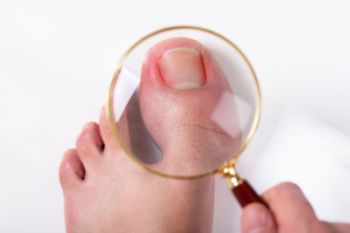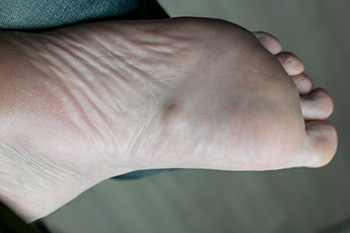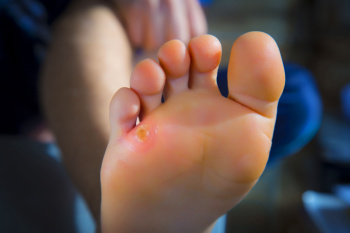Connect With Us
Blog
Items filtered by date: August 2025
Treatment Options for Ingrown Toenails

Ingrown toenails can range from mildly uncomfortable to severely painful and infected. For more advanced cases, a podiatrist may lift and trim the ingrown portion of the nail or perform a partial nail removal to relieve pressure and allow proper healing. If the problem is recurrent, a procedure can be done to remove part of the nail root using a chemical or laser to prevent regrowth in that area. In cases of severe infection or persistent ingrowth, full nail removal may be recommended. These treatments aim to reduce pain, prevent infection, and correct nail growth. If left untreated, an ingrown toenail can lead to deeper infection and more serious complications. If you have a persistent ingrown toenail, it is suggested that you see a podiatrist for a diagnosis and treatment that best suits your condition.
Ingrown toenails can become painful if they are not treated properly. For more information about ingrown toenails, contact Michael Schwartzman, DPM of Illinois and Indiana . Our doctor can provide the care you need to keep you pain-free and on your feet.
Ingrown Toenails
Ingrown toenails occur when a toenail grows sideways into the bed of the nail, causing pain, swelling, and possibly infection.
Causes
- Bacterial infections
- Improper nail cutting such as cutting it too short or not straight across
- Trauma to the toe, such as stubbing, which causes the nail to grow back irregularly
- Ill-fitting shoes that bunch the toes too close together
- Genetic predisposition
Prevention
Because ingrown toenails are not something found outside of shoe-wearing cultures, going barefoot as often as possible will decrease the likeliness of developing ingrown toenails. Wearing proper fitting shoes and using proper cutting techniques will also help decrease your risk of developing ingrown toenails.
Treatment
Ingrown toenails are a very treatable foot condition. In minor cases, soaking the affected area in salt or antibacterial soaps will not only help with the ingrown nail itself, but also help prevent any infections from occurring. In more severe cases, surgery is an option. In either case, speaking to your podiatrist about this condition will help you get a better understanding of specific treatment options that are right for you.
If you have any questions, please feel free to contact our offices located in West Chicago, IL and Whiting, IN . We offer the newest diagnostic and treatment technologies for all your foot care needs.
Understanding Lederhose Disease

Plantar fibromatosis, also known as Lederhose disease, is a condition marked by the development of firm nodules in the arch of the foot within the plantar fascia. These benign growths are usually slow-forming and may cause pain, pressure, or discomfort while walking or standing. Symptoms include noticeable lumps, tightening of the fascia, and difficulty in wearing shoes. Risk factors may involve genetics, repeated foot trauma, or certain health conditions, such as diabetes or epilepsy. A podiatrist can evaluate the condition through physical examination and imaging, offering treatments like orthotics, or surgical options, if needed. If you notice unusual lumps in the arch of your foot, or have foot pain, it is suggested that you consult a podiatrist for an expert diagnosis and personalized care.
A plantar fibroma may disrupt your daily activities. If you have any concerns, contact Michael Schwartzman, DPM of Illinois and Indiana . Our doctor can provide the care you need to keep you pain-free and on your feet.
Plantar Fibroma
A plantar fibroma is a fibrous knot in the arch of the foot. It is embedded in the plantar fascia which is a band of tissue that extends from the heel to the toes along the bottom of the foot. There can be multiple plantar fibromas in the feet at the same time. There are no known causes for this condition. If you have a plantar fibroma, there will be a bump in the arch of your foot that cannot be missed. Any associated pain is most often due to a shoe rubbing against the nodule. Non-surgical options, such as steroid injections, physical therapy, and orthotics should be tried first. Surgery is a last resort and is the only thing that will remove a plantar fibroma entirely. Consult with a podiatrist for a proper diagnosis and to determine the treatment regimen that is right for you.
What Causes a Plantar Fibroma?
While there are no specific causes identified, a plantar fibroma can possibly come from genetic predisposition or the formation of scar tissue that forms from healing the tears in the plantar fascia.
What Are the Symptoms of a Plantar Fibroma?
There will be a noticeable lump in the arch of the foot that may or may not cause pain. If pain is felt, it is typically because a shoe is rubbing up against the lump or when walking or standing barefoot.
Treatment and Prevention
A plantar fibroma will not disappear without treatment, but it can get smaller and be a non-issue. If pain persists, a podiatrist examines the foot and when the arch of the foot is pressed, pain can be felt down to the toes. An MRI or biopsy might be performed to help diagnose or evaluate the plantar fibroma. The following non-surgical options are generally enough to reduce the size and pain of these nodules:
- Steroid injections
- Orthotics
- Physical therapy to help apply anti-inflammatory creams on the bump
Surgery is considered if the mass increases in size and the patient continues to feel pain after non-surgical methods are tried.
If you have any questions, please feel free to contact our offices located in West Chicago, IL and Whiting, IN . We offer the newest diagnostic and treatment technologies for all your foot care needs.
A Podiatrist Can Provide Relief for Corn Pain

Corns are thickened areas of skin that form in response to friction or pressure. Hard corns often appear on the tops of toes, the soles of the feet, or the side of the little toe, while soft corns usually develop between toes where the skin stays moist. These painful spots result from wearing tight shoes, abnormal toe positioning, or repeated rubbing against footwear. Over time, corns can make walking uncomfortable and lead to further complications. A podiatrist can accurately diagnose the type of corn, safely remove the thickened skin, and recommend methods to prevent recurrence. If you have a painful corn, it is suggested that you consult a podiatrist who can offer effective relief and treatment tips.
If you have any concerns regarding your feet and ankles, contact Michael Schwartzman, DPM of Illinois and Indiana . Our doctor will treat your foot and ankle needs.
Corns: What Are They? and How Do You Get Rid of Them?
Corns can be described as areas of the skin that have thickened to the point of becoming painful or irritating. They are often layers and layers of the skin that have become dry and rough, and are normally smaller than calluses.
Ways to Prevent Corns
There are many ways to get rid of painful corns such as wearing:
- Well-fitting socks
- Comfortable shoes that are not tight around your foot
- Shoes that offer support
Treating Corns
Treatment of corns involves removing the dead skin that has built up in the specific area of the foot. Consult with Our doctor to determine the best treatment option for your case of corns.
If you have any questions, please feel free to contact our offices located in West Chicago, IL and Whiting, IN . We offer the newest diagnostic and treatment technologies for all your foot care needs.
